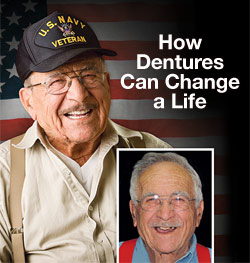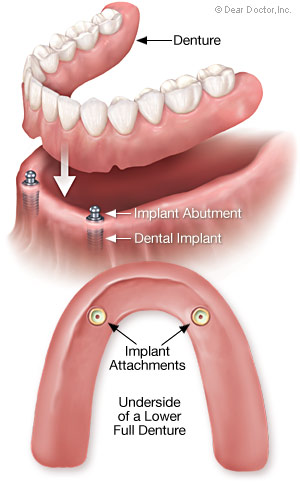Removable Full Dentures
A time-tested, affordable way to replace missing teeth

Edentulism — Still a Real Problem
“Edentulism,” the complete loss of all permanent teeth, can substantially reduce quality of life, self-image, and daily functioning. At the dawn of the 21st Century, with all the know-how necessary to ensure dental and oral health, complete tooth loss is still a big issue. In the U.S., 26% of adults between the ages of 65 and 74 years have lost all their teeth. In some other countries, the percentage is even higher.
Not only do these individuals suffer a reduced quality of life, but they also are at risk for nutritional problems and multiple systemic (health) disorders. The ravages of untreated periodontal (gum) disease and dental caries (tooth decay) are direct causes of tooth loss. But what other factors drive complete tooth loss? Lack of access to education, preventive care, exposure to fluoride, dental treatment and adequate financial resources all play a role.
 |
| An affordable and elegant solution for tooth loss Over 25% of Americans have lost their teeth by age 65. Nick is similar to many elderly Americans who have lost most, if not all their teeth. His few remaining teeth were no longer functional or attractive. Removable full dentures dramatically transformed his smile and improved his oral and general health. As you can see he is a proud American, who now enjoys eating, talking and smiling again — with confidence. Click to enlarge |
When Teeth Are Lost, Bone Is Lost
The problem of tooth loss actually extends into one of bone loss. It's a “You scratch my back and I'll scratch yours” story. Alveolar bone (from “alveolus” meaning sac-like) surrounds, supports and connects to the teeth via the periodontal ligament (“peri” – around; “odont” – tooth). Though we sometimes think of bone as a hard, static substance, it is in fact always changing and reforming. But to keep doing this, it needs to receive a signal, or stimulus. In the case of alveolar bone, that stimulus comes from the movement of the periodontal ligament attaching it to the teeth. When the teeth are lost, the stimulus necessary to keep the alveolar bone healthy disappears and the bone itself resorbs or melts away. Worse yet, when pressure is transmitted by dentures through the gum tissues to the jawbone, it atrophies further (“a” – without; “trophy” – growth), accelerating its loss.
Elegant Solutions
Removable full denture prosthetics (false teeth) can be challenging for both doctor and patient. A great deal of art and experience goes into their molding and fabrication, and wearing them comfortably takes practice. Yet, when well made, they can be elegant solutions for replacing missing teeth and the surrounding bone and gum tissue. They are often a very viable option for restoring function and appearances after complete tooth loss.
Full dentures have not held a place of reverence in dentistry compared to fixed bridgework, implants, and cosmetic dentistry. Many dentists have avoided incorporating removable dentures into their practices, yet these devices remain a viable and significantly more affordable alternative for restoring function and well-being.

Preparing the Way
Unless individuals are prepared and counseled by their dental health professionals, transitioning to full dentures can be traumatic — both physically and psychologically. When loss of all one's teeth is imminent, pre-planning can minimize trauma and enhance acceptance by providing more time to learn how to “wear” and use one's new teeth.
Transitional, also known as “immediate,” dentures can be fabricated ahead of time in anticipation of tooth loss so that at no time is one without teeth. A good guide for making aesthetic and functional dentures is of course your old teeth — whether they are natural or a temporary set of false teeth. Photographs can be extremely helpful to this process as they provide a glimpse of how you used to look, want to look again, or even how you might want to change your appearance.
Immediate dentures also facilitate the healing process, protecting the healing tooth sockets immediately after tooth extraction. Inevitably there will be some bone loss as the tissues heal and re-mold themselves. This inevitably involves tissue shrinkage, most of which occurs in the first year. Thus the immediate dentures will need to be relined after 6-9 months, or remade in order to conform and adapt more accurately to the healed state.
Alveolar bone loss can be minimized during the extraction process by bone grafting techniques to maintain bone volume, which can be critical to denture stability. Most often, the bone grafting materials are obtained in a sterile powdered form from either human (allograft) or an animal species (xenograft). Using these materials, bone grafting is a relatively simple procedure that acts as a scaffold upon which the body builds and maintains its own bone. Bone loss can also be prevented by retaining well-positioned tooth roots — removing the crowns of the teeth, but retaining and submerging the roots beneath the gum tissue. In addition, bone loss can be both prevented and stabilized by strategically placing as few as two traditional dental implants, or by using mini-implants, to transmit the biting forces through the implants instead of directly onto the bone via pressure from the dentures.




